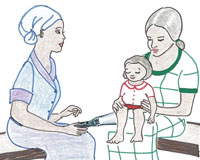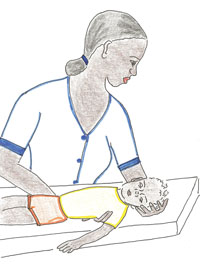6.2.2 Assessing for other diseases
If you assess the child as not having malaria, you need to consider other possible causes for the child’s fever.
ASK: How long has the child had fever?
If the fever has been present for more than seven days, ask if the fever has been present every day.
Most fevers due to a virus infection go away within a few days. A fever which has been present every day for more than seven days can mean that the child has a more severe disease. In this case you should refer the child for further assessment.
ASK: Has the child had measles within the last three months?
A child with fever and a history of measles within the last three months may have an infection due to complications of measles.
LOOK or FEEL for stiff neck
A child with fever and a stiff neck may have meningitis. A child with meningitis needs urgent treatment with injectable antibiotics and referral to a hospital.
While you talk with the mother during the assessment, look to see if the child moves and bends his neck easily as he looks around. If the child is moving and bending his neck, he does not have a stiff neck.

If you did not see any movement, or if you are not sure, draw the child’s attention to his umbilicus or toes. For example, you can shine a flashlight on his toes or umbilicus or tickle his toes to encourage the child to look down (see Figure 6.1). Look to see if the child can bend his neck when he looks down at his umbilicus or toes.

If you still have not seen the child bend his neck himself, ask the mother to help you lie the child on his back. Lean over the child; gently support his back and shoulders with one hand. With the other hand, hold his head. Then carefully bend the head forward toward his chest (see Figure 6.2). If the neck bends easily, the child does not have a stiff neck. If the neck feels stiff and there is resistance to bending, the child has a stiff neck. Often a child with a stiff neck will cry when you try to bend his neck.
LOOK or FEEL for bulging fontanelle (age less than 12 months)
Hold the infant in an upright position. The infant must not be crying. Then look at and feel the fontanelle. The fontanelle is the soft (not hard or bony) part of the head normally found in infants. If the fontanelle is bulging rather than flat, this may mean the young infant has meningitis.
LOOK for runny nose
A runny nose in a child with fever may mean that the child has a common cold. When malaria risk is low, a child with fever and a runny nose does not need antimalarial drugs. The fever is probably due to the common cold.
6.2.1 Assessing for malaria
